
- •Г.Ф.Крівчикова
- •Педагогічних внз денних та заочних форм навчання
- •Видано за рахунок автора
- •© Харківський націоальний університет імені г.С.Сковороди
- •© Г.Ф.Крівчикова
- •Contents
- •Module 1
- •Module 2
- •Requirements to the course of english literature
- •Завдання вивчення дисципліни
- •Завданнями навчальної дисципліни є формування наступних умінь:
- •Glossary of literary terms
- •How to prepare a book review
- •Critical Comments
- •Critical Reading includes:
- •Module 1 lecture #1. Anglo-Saxon (Old) Literature (450-1066)
- •Lecture # 3 The writers of the Medieval English Literature
- •Lecture # 4 The Literature of the 15th Century
- •Lecture # 5 The Literature of the Renaissance (1509-1660)
- •Lecture # 6 William Shakespeare (1564-1616)
- •Lecture # 7 The Puritan Period – the third period of English Renaissance (1616 – 1660)
- •Excerpt I [the hall heorot is attacked by grendel]
- •Excerpt II [the feast at heorot]
- •Excerpt III
- •In due season
- •Excerpt IV [beowulf's fight with the dragon]
- •Excerpt IV [beowulf’s funeral]
- •2. Anglo-Saxon Riddles
- •Riddle 1
- •Riddle 2
- •Is strangely born. Savage and fierce,
- •Is harder than ground, smarter than men.
- •In beautiful tones, teems with children,
- •Riddle 3
- •I must eagerly obey my servant,
- •Riddle 4
- •Riddle 5.
- •Riddle 6.
- •Riddle 7
- •The battle of maldon
- •Seminar #2 Geoffrey Chaucer “Canterbury Tales”
- •Summing up study questions.
- •2. "General Prologue" to Canterbury Tales
- •4. The Knight's Tale
- •5. The Miller’s Tale.
- •3. "The Pardoner's Prologue and Tale."
- •7. The Wife of Bath's Tale. (Батской ткачихи)
- •Seminar #3 English Folk Ballads
- •The banks of allan water
- •The two magicians
- •The tree ravens
- •The cruel brother
- •With a hey ho and a lillie gay
- •The cruel sister
- •The wife of usher’s well
- •Bonny barbara allan
- •8.The farmer’s curst wife
- •10. Robin hood and little john
- •Seminar #4. William Shakespeare "othello". Questions on the structure of "othello".
- •Questions to discuss
- •Analysing literary devices
- •Analyzing Style
- •5. Fill in the style chart.
- •Edmund spencer sonnet 75
- •William shakespeare
- •Sonnet 18
- •William shakespeare Sonnet 130
- •William shakespeare Sonnet 116
- •William shakespeare Sonnet 60
- •William shakespeare Sonnet 147
- •Ben johnson poem
- •John donne holy sonnet X
- •Individual work
- •Lecture # 10 The Romantic Period (1780 – 1830)
- •Lecture # 11 High Victorian Literature (1830 - 1880)
- •Lecture # 12 Late Victorian and Edwardian Literature (1880 - 1910)
- •Lecture # 13 English Literature of the 20th century (the period between 1910 – 1938)
- •Modernism and its Alternatives
- •The Theatre of Absurd.
- •Lecture # 14 English Literature of the 20th century
- •Lecture # 15 English Literature of the 20th century
- •Jonathan swift "gulliver's travels" Study Questions
- •William blake "the tiger" (from “Songs of Experience)
- •(From Songs of Innocence) The Chimney-Sweeper
- •(From “Songs of Experience”) The Chimney-Sweeper
- •Songs of Innocence Nurse's Song
- •Songs of Experience Nurse's Song
- •John keats "on first looking into chapman's homer".
- •John keats
- •William wordsworth "london, 1802".
- •William blake london
- •William wordsworth " composed upon westminster bridge ".
- •S.T.Coleridge From the rime of the ancient mariner
- •George Gordon Byron From don juan
- •Percy Bysshe Shelly Ode to the West Wind
- •Seminar #9 charles dickens "great expectations" summary questions
- •(Chapters 20-31)
- •Techniques and language
- •Characters’ struggle to cut off or separate part of their lives:
- •Read and analyse a play by one of the writers of the period.
- •Read a play by Harold Pinter
- •2. Write an analysis of one of the short stories of an English writer of the 20th century analyzing a short story.
- •Point of view
- •1. First-Person Central.
- •2. First Person Minor
- •3. Third - Person Limited.
- •4. Third - Person Central:
- •5. Third - Person Omniscient.
- •One can analyse the point of view by answering the following questions about a given story:
- •General questions for story analysis and interpretation.
- •Individual work
- •Оценивание работы студентов
- •61002, М.Харків, вул.Сумська, 37. Тел.(057)700-53-51.
Lecture # 15 English Literature of the 20th century
1960 – 2000
Anthony Powell “Casanova’s Chinese Restaurant”(1960), “The Kindly Ones”(1962), “The Valley Of Bones”(1964)
Anthony Burgess “The Doctor is Sick”(1960), “A Clockwork Orange”(futuristic novel, 1962), “Inside Mr. Enderby”(1963), “The Eve of Saint Venus”(1963)
Peter Shaffer “Five-Finger Exercise”(play, 1960), “The Roayl Hunt of the Sun”(play, 1964)
Stan Barstow “A Kind of Loving”(1960)
David Story “This Sporting Life”
Graham Greene “The Burnt Out Case”(1961)
Arthur C.Clarke “A Fall of Moondust ”(science fiction novel, 1961)
John Osborne “Luther”(play, 1961), “Tom Jones”(1963)
Winston Graham “Marnie”(crime novel, 1961)
Iris Murdoch “A Severed Head”(1961), “The Italian Girl”(1964)
Ian Fleming “Thenderball” (1961)
Doris Lessing “The Golden Notebook”(1962), “African Stories”(1964)
Brian Aldiss “Hothouse”(science fiction novel, 1962)
John Wain “The Contenders”(1958), “Strike the Father Dead”(1962)
John Braine “Room at the Top”(1957), “Life at the Top”(1962)
Muriel Spark “The girls of Slender Means”(1963)
H.E.Bates “A Moment in Time”(1964)
Christopher Isherwood “A Single Man”(1964)
William Golding “The Spire”(1964)
1965

1966

1967
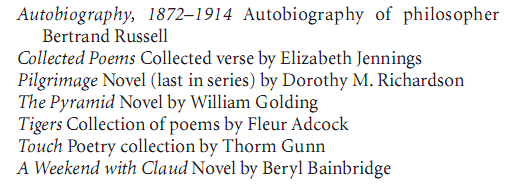
1968
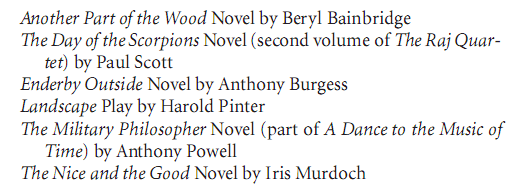
1969
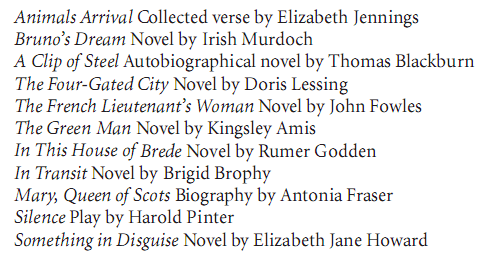
1970

1971

1972
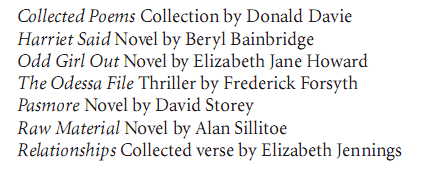
1973

1974
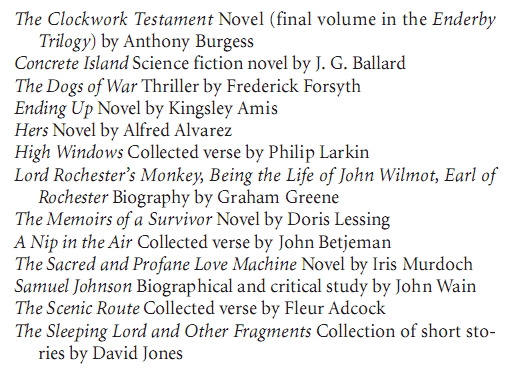
1975
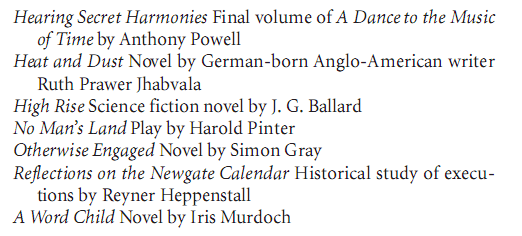
1976

1977
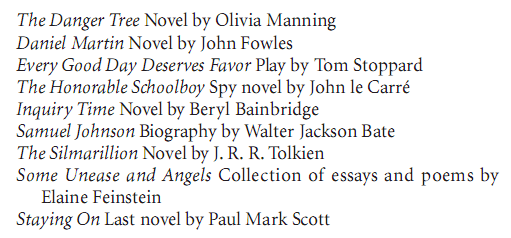
1978
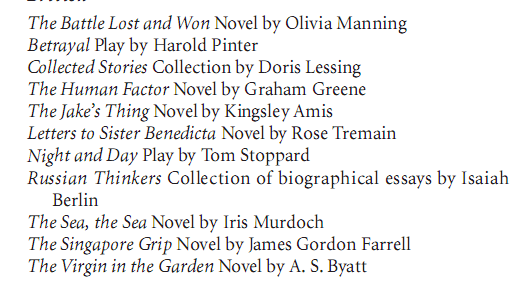
1979
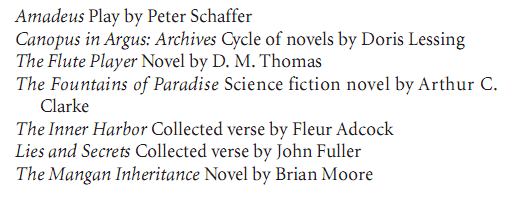

1980
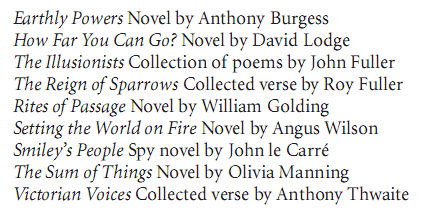
1981

1982
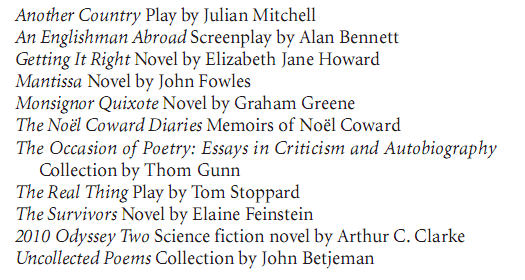
1983

1984

1985


1986

1987

1988

1989
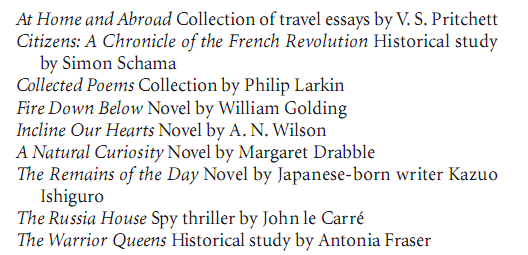
1990
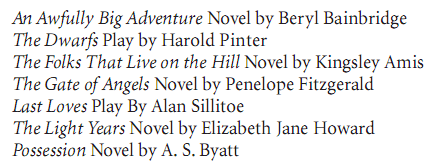
1991

1992
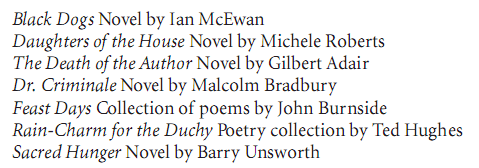
1993
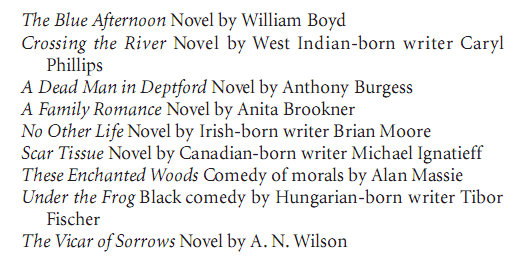
1994

1995

1996


1997
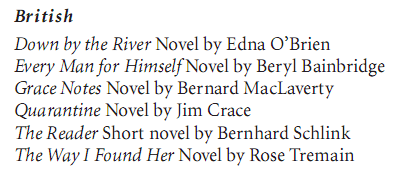
1998
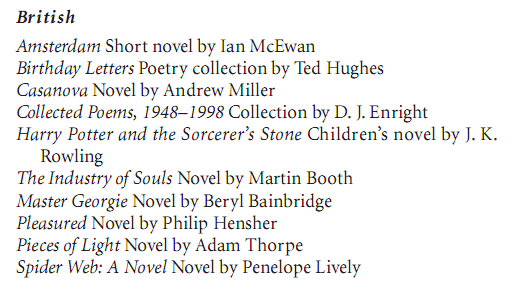
1999
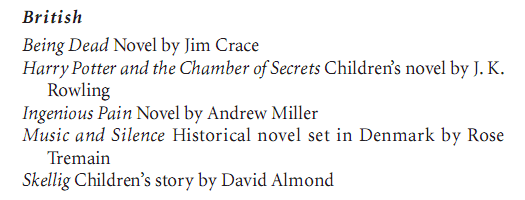
2000
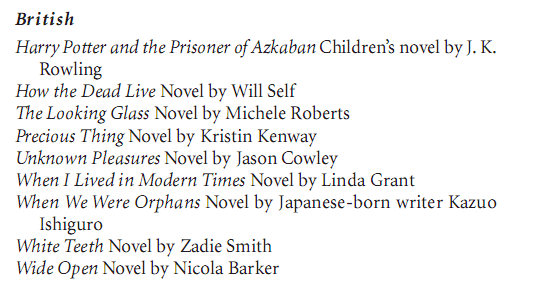
SEMINAR #6
The writers of the Enlightenment
DANIEL DEFOE “ROBINSON CRUSOE”
Study Questions
1. At the beginning of the novel, what is Robinson Crusoe's attitude towards God and religion?
2. What evidence can you find in Crusoe's youth to determine his capitalism?
3. What are Crusoe's attitudes towards women in the latter part of the novel?
4. How many years was Crusoe on the island?
5. Do you think that Defoe meant this novel to be a moral tale? If so, what was the moral?
6. Could Crusoe be considered a "racist"?
7. Defoe has his hero practice two different types of writing in the novel. One type is the journal that Crusoe keeps for a few chapters until his ink runs out. The other is the fuller type of storytelling that makes up the bulk of the novel. Both are in the first-person voice, but they produce different effects. Why does Defoe include both types? What does a comparison between them tell us about the overall purpose of the novel?
8. Crusoe expresses very little appreciation of beauty in the novel. He describes the valley where he builds his bower as pleasant, recognizes that some of his early attempts at potter}-' making are unattractive, and acknowledges that Friday is good-looking. But overall, he shows little interest in aesthetics. Is this lack of interest in beauty an important aspect of the character of Crusoe, or of the novel?
9. Crusoe spends much time on the island devising ways to escape it. But when he
finally does escape, his return to Europe is anticlimactic. Nothing he finds there, not
even friends or family, is described with the same interest evoked earlier by his fortress or farm. Indeed, at the end of the novel Crusoe returns to the island. Why does Defoe portray the island originally as a place of captivity and then later as a desired destination?
10. Although he is happy to watch his goat and cat population multiply on his island, Crusoe never expresses any regret for not having a wife or children. He refers to his pets as his family, but never mentions any wish for a real human family. While he is sad that his dog never has a mate, he never seems saddened by his own thirty-five years of bachelor existence. Does Crusoe's indifference to mating and reproduction tell us anything about his view of life, or about the novel?
11. In many ways Crusoe appears to be the same sort of person at the end of the novel as he is at the beginning. Despite decades of solitude and exile, wars with cannibals, and the subjugation of a mutiny, Crusoe hardly seems to grow or develop. Is Crusoe an unchanging character, or does he change in subtle ways as a result of his ordeal?
12. Crusoe's religious illumination, in which he beholds an angelic figure descending on a flame, ordering him to repent or die, is extremely vivid. Afterward he does repent, and his faith seems sincere. Yet Defoe complicates this religious experience by making us wonder whether it is instead a result of Crusoe's fever, or of the tobacco and rum he has consumed. We wonder whether the vision may be health- or drug-related rather than supernatural and divine. Why does Defoe mix the divine and the medical in this scene? Does he want us to question Crusoe's turn to religion?
13. Consider the prominent role that religion plays in the novel and examine the progression of religious and political thought in Crusoe's "society."
14. What are Crusoe’s two major requirements of a good Chrisrian?
15. How does Crusoe reconcile his urge to kill cannibals with his religious beliefs?
